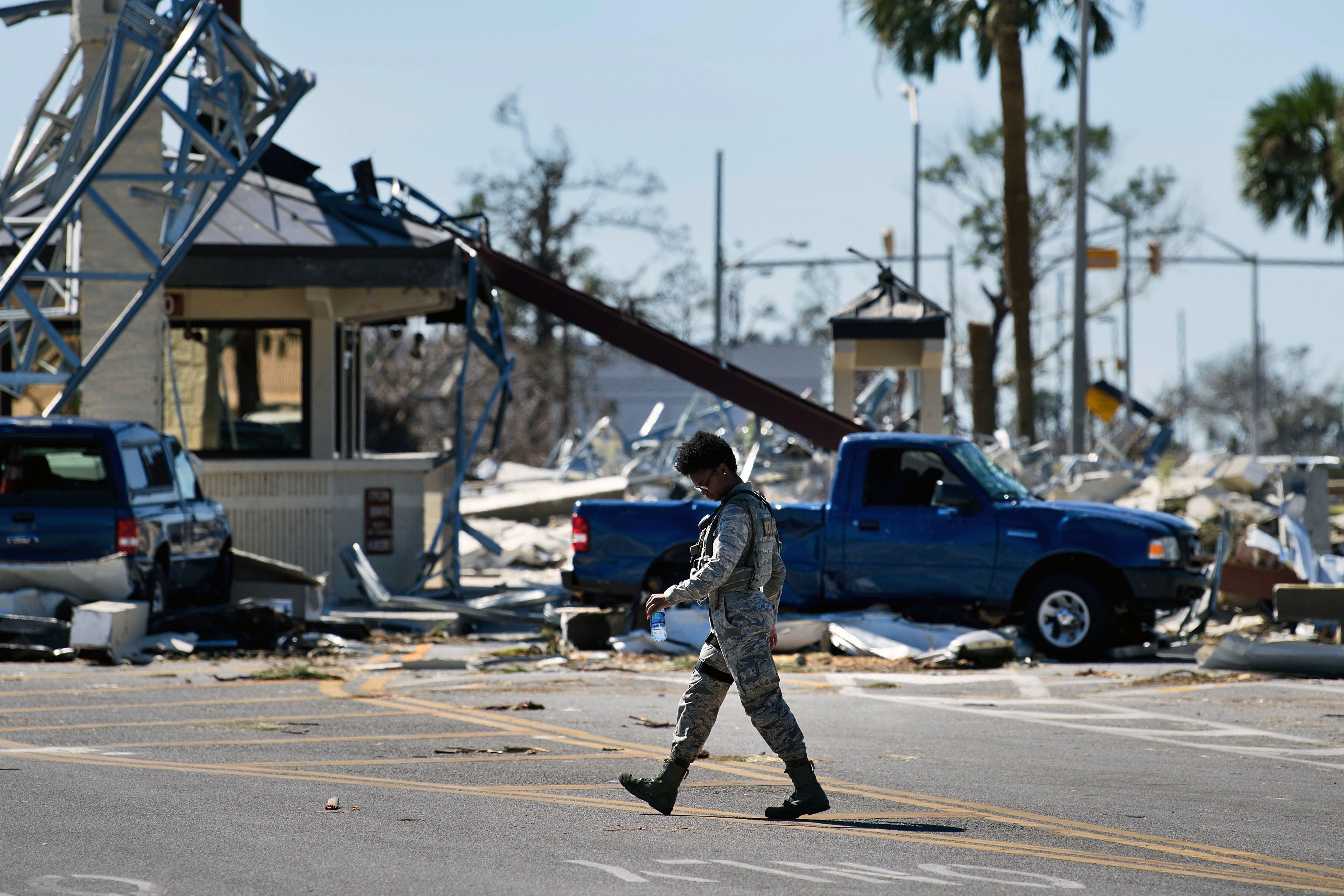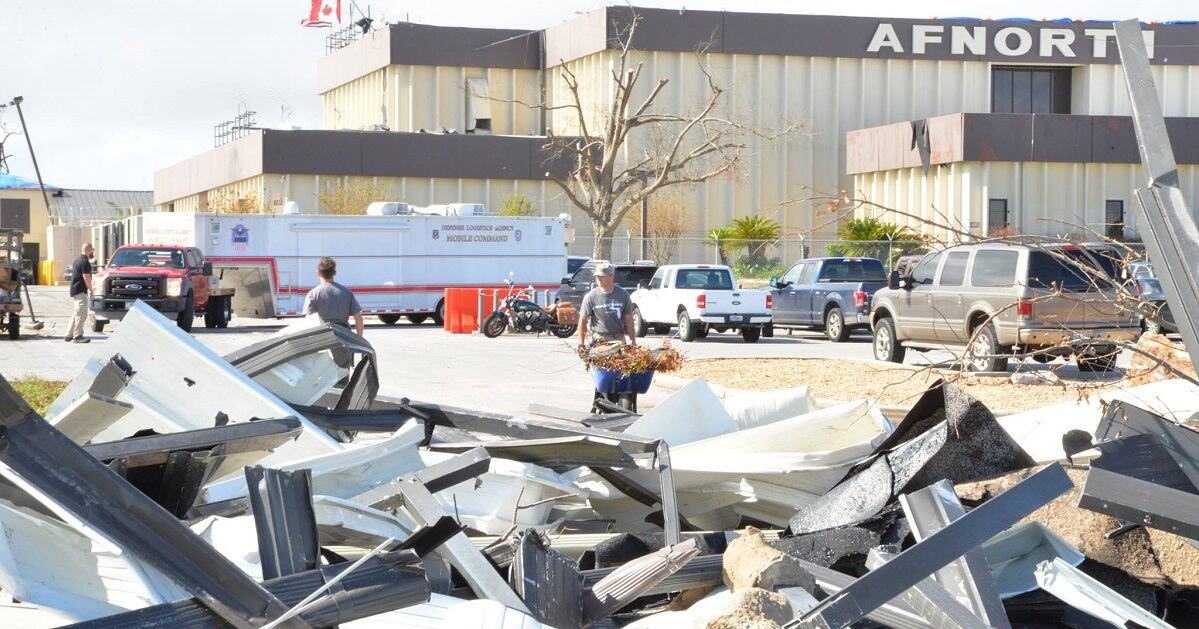BRADENTON, Fla. (AP) — Longtime Sarasota-area resident Chris Dillon is no stranger to hurricanes.
Riding out a direct hit from Hurricane Michael at Tyndall Air Force Base in October tested the nerve of the Air Force veteran, who is now a lieutenant colonel in the Florida Army National Guard. It also spurred him to double down on preparedness plans for his family.
The National Hurricane Center recently upgraded Michael’s status at landfall to a Category 5 storm, with 160-mph winds and a 14-foot storm surge. The hurricane caused $25 billion in damage, and killed 16 people.
Dillon has been in about nine hurricanes total, after growing up in Sarasota and serving since 1997 in the Florida Guard, responding during and after storms hit the peninsula. Usually, he and fellow Guardsmen are driving into the storms during landfall, positioning resources to help Floridians in the first days and weeks of the recovery process.
RELATED

Michael’s wrath was unlike any that he had seen. Dillon was one of about 50 U.S. and Canadian military personnel who sheltered in a building with reinforced concrete walls.
He was the air defense coordinating officer for the National Capital Region Integrated Air Defense System while serving at Tyndall, where 1st Air Force (Air Forces Northern) is headquartered.
“Because Tyndall was the center, we had the front part of the storm hit us really hard,” Dillon said. “It was so loud, even though I was in a building with 3-foot poured walls. The sky was gray green. When the storm hit on that side, it was deafening at times.”
Though Dillon is a seasoned hurricane veteran, even he has re-evaluated his personal evacuation and preparation strategies in light of Michael.
After Dillon sent officers working for him to safety, he realized he was too tired to drive up the rural roads through Alabama. So he stayed.

Although he had been "fairly confident" that the building would hold up, Michael tore the roof off and forced military personnel to move from the second floor to the first after water started pouring in. He remembers a Canadian officer's calm but dire warning.
"We continued to move around the building. Certain parts of the building were coming down. The roof was getting ripped off," Dillon said. "I remember him saying, 'Hey, if it gets any worse you have to get under the desk.' That's kind of where we were."
When Michael’s 14-mile-wide eye crossed over, they cautiously ventured outside and caught a glimpse of the base, where all of the 700 buildings were reported damaged and about a third were destroyed.
"All the aluminum and steel, the hangars and all the aluminum walkways, the majority of them were shredded and winds made them fly into things and cause more damage," Dillon said.
Then the other side of the hurricane hit and sent them back inside.
The back side of the storm, he said, "wasn't as violent, but it felt like there was more water."
After the hurricane passed, they walked outside to survey the devastation. All of the vehicles that had been left behind, including an older truck that Dillon was in the process of restoring, were damaged or destroyed.
Rocks had hurtled through the air and cut deep ridges in the paint of his truck. Another rock had blown out the back window and allowed several gallons of water to get inside. But he was one of the lucky ones.

"There were cars turned over. There were cars, the water got so high and the wind, it made them slam in together," he said. "There wasn't one car that didn't experience anything."
But everyone on the base was safe.
"At the end of the day, when we walked out of the building that we were in, it didn't matter that everybody's car had rocks go through them or were flipped, it was that we were alive," Dillon said. "That's what was important."
After the storm
Dillon kept a large, framed photo of Tyndall Air Force Base’s “Stay Behind Team” outside the building where they took shelter. The first thing they did was inspect the roof and put the Canadian and American flags atop the building.
Regardless of rank, everyone went to work cleaning up what they could.
"We had a three-star general down to a staff sergeant working with us. Everybody walked out and just started cleaning up," Dillon said. "We started taking care of everybody. We tried to get ahold of whatever families were there. That was probably one of the hardest things — that took a couple of days, to find the families."
For the first time during his post-hurricane experience, communications were out. He was able to use Facebook Messenger at times. One carrier occasionally had a signal and officers took turns using that phone.
"We had zero phone service. My wife was trying to get in touch with me. It took a couple of days," he said.
Normally as a Guardsman, Dillon is equipped with radios and other different means of communication. Instead of rendering assistance as he usually does post-storm, he found himself on the receiving end.
The house he was renting in Mexico Beach washed off its foundation when Michael's 14-foot surge crashed ashore.
When he returned to his rental home three months later, it was an odd sight. Two bedrooms were unscathed, the beds still made. The rest of the home looked like it had been picked up and shaken, with a foul, sulfur-smelling muck coating the floor. The roof was ripped off and a neighbor's truck and a pile of debris were lodged on the steps in front of where his house once stood.
Mexico Beach bore the brunt of storm, with 1,584 buildings of 1,692 reported damaged, and 809 of those destroyed, according to the National Hurricane Center's post-Michael report.
Dillon's elderly, disabled neighbors decided to stay, and survived even though they were found in their home in chest-high water after the storm. One of his colleagues, a lieutenant, had her rental home swept out to sea. Two weeks after the storm, a black box containing military uniforms and equipment was found about a half-mile away and returned to her.
"The people in Mexico Beach, there's a lot of people that stayed," Dillon said, adding that Michael and 2017?s Hurricane Irma reinforced the imperative that people evacuate the coasts. Most of the direct-cause deaths were by drowning. Of the seven deaths in Florida, five people who drowned were in evacuation zones.
"You just want to get off the coast with something like that coming. Even 100 miles off the coast is better than being on the coast," he said. "If you can get out, get out. You don't need that experience, especially if you're near the coast. With Irma, people in the center of the state, their houses were destroyed."
One for the record books
Last year's hurricane season produced several record-breaking storms that unleashed damage from winds, surge and inland flooding.
According to the National Hurricane Center:
♦ Michael is tied with the San Felipe Hurricane of 1928 as the fourth strongest hurricane to strike the United States (including Puerto Rico), since 1900, behind the Labor Day Hurricane (1935), Camille (1969) and Andrew (1992).
♦ Michael is also the strongest hurricane landfall in the Florida Panhandle and only the second known Category 5 landfall on the northern Gulf Coast.
♦ Michael marks the latest date that a Category 5 hurricane made landfall in the United States.
Cleanup and recovery efforts will continue for years in the Florida Panhandle and southern Georgia.

In a visit to the Panhandle on May 8, President Donald Trump said the Department of Housing and Urban Development would be granting $448 million to the state for hurricane response, according to the Military Times. The area had received $1 billion in disaster aid through April.
In North Carolina, Category 4 Hurricane Florence was blamed for 22 direct deaths and 30 indirect deaths, most caused by inland flooding after a record 36 inches of rain fell. Florence caused $24 billion damage, according to the NHC.
As always, emergency managers and hurricane experts urge the public to prepare each year before hurricane season begins June 1. But too often, preparedness pleas fall on deaf ears.
Dillon, as a former insurance claims adjuster and now as an insurance agent, sees the risk and does what he can to advocate preparedness.
"Sarasota is definitely an area that has the potential to have a lot of damage. The whole Gulf Coast, we've been very lucky," he said, noting that few have been around long enough to remember Hurricane Donna. "The longer it gets in the past, the less prepared we get."
He recommends grabbing a copy of the Herald-Tribune’s annual Hurricane Guide, which is available online at HeraldTribune.com/hurricane.
"It's got the list of things you need," Dillon said. "As a Guardsman, I always kept that part and put it in my house and I had one at the armories."
Experts advise coastal residents to prepare now. Use cell phones to do a video or photo inventory of all belongings, and keep essential food and water supplies as well as insurance documents in a waterproof container that you can toss in the car if you are ordered to evacuate. Don't forget to prepare for pets, as well.
"You go through your belongings and you find what's really important," he said of his own preparation for Michael in the Panhandle. "That's the thing that you've got to do now, before hurricane season."
Michael has changed Dillon's evacuation plans for his family.
"Me personally, anything above a Cat 3, I'm getting out," Dillon said. "As long as I'm in the Guard, I'm staying. My family though, I'm going to try to get them out and get them into a safe place. You don't know when that storm's going to blow up and become a Michael or an Andrew."
Vicki Dean is a freelance writer based in Venice.
Information from Sarasota (Fla.) Herald-Tribune,





